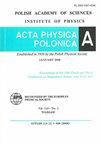Photoactivity of Dopped TiO2 Thin Films by Ion Sputter Deposition
IF 0.5
4区 物理与天体物理
Q4 PHYSICS, MULTIDISCIPLINARY
引用次数: 0
Abstract
Titanium dioxide is well known as a photoactive material to be activated under ultraviolet irradiation and is either employed as a photocatalyst or exhibits superhydrophilic behavior after reducing the surface energy under illumination for self-cleaning or anti-fogging surfaces. For increasing the reactivity of the thin films under solar illumination, a reduced band gap is desired. Doping with transition metals or with nitrogen has been reported in the literature. However, the incorporation of nitrogen into the growing film is a much more complex process, which is presently not completely understood. TiO 2 thin layers were produced by ion beam sputter deposition, which should allow the usage of temperature-sensitive substrates. The deposition has been performed in the existing experimental setup, previously used for investigations on Ag and Ge thin film physical vapor deposition processes, where the influence of the sputtered and reflected particles and their accompanying energy flux on the grain size, surface morphology, and conductivity have been measured. By adjusting the geometry between the incident ion beam, the sputter target, and the substrate, independently from the primary ion energy and species, a controlled deposition of samples was possible. Conventional ion implantation was employed to implant either carbon or nitrogen ions below the surface for bandgap engineering. The resulting thin films have subsequently been investigated for optical properties, stoichiometry, structural properties, surface topography, and photoactivity. The aim was to find an optimized geometry and to determine the exact particle and energy flux necessary for these conditions. Thus, the process opens up for transfer or scaling when assuming future industrial applications.离子溅射沉积掺杂TiO2薄膜的光活性
本文章由计算机程序翻译,如有差异,请以英文原文为准。
求助全文
约1分钟内获得全文
求助全文
来源期刊

Acta Physica Polonica A
物理-物理:综合
CiteScore
1.50
自引率
0.00%
发文量
141
审稿时长
6 months
期刊介绍:
Contributions which report original research results
and reviews in the fields of General Physics, Atomic and
Molecular Physics, Optics and Quantum Optics, Quantum Information, Biophysics, Condensed Matter, and
Applied Physics are welcomed.
 求助内容:
求助内容: 应助结果提醒方式:
应助结果提醒方式:


